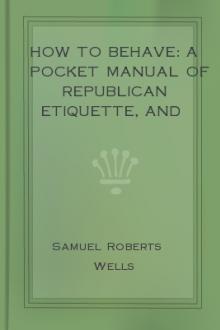Essays, Thomas Paine [digital book reader .txt] 📗

- Author: Thomas Paine
Book online «Essays, Thomas Paine [digital book reader .txt] 📗». Author Thomas Paine
The English funding system began one hundred years ago; in which time there have been six wars, including the war that ended in 1697.
The war that ended, as I have just said, in 1697.
The war that began in 1702.
The war that began in 1739.
The war that began in 1756.
The American war, that began in 1775.
The present war, that began in 1793.
The national debt, at the conclusion of the war which ended in 1697, was twenty-one millions and an half. (See Smith’s Wealth of Nations, chapter on Public Debts.) We now see it approaching fast to four hundred millions. If between these two extremes of twenty-one millions and four hundred millions, embracing the several expenses of all the including wars, there exist some common ratio that will ascertain arithmetically the amount of the debts at the end of each war, as certainly as the fact is known to be, that ratio will in like manner determine what the amount of the debt will be in all future wars, and will ascertain the period within which the funding system will expire in a bankruptcy of the government; for the ratio I allude to, is the ratio which the nature of the thing has established for itself.
Hitherto no idea has been entertained that any such ratio existed, or could exist, that would determine a problem of this kind; that is, that would ascertain, without having any knowledge of the fact, what the expense of any former war had been, or what the expense of any future war would be; but it is nevertheless true that such a ratio does exist, as I shall show, and also the mode of applying it.
The ratio I allude to is not in arithmetical progression like the numbers 2, 3, 4, 5, 6, 7, 8, 9; nor yet in geometrical progression, like the numbers 2, 4, 8, 16, 32, 64, 128, 256; but it is in the series of one half upon each preceding number; like the numbers 8, 12, 18, 27, 40, 60, 90, 135.
Any person can perceive that the second number, 12, is produced by the preceding number, 8, and half 8; and that the third number, 18, is in like manner produced by the preceding number, 12, and half 12; and so on for the rest. They can also see how rapidly the sums increase as the ratio proceeds. The difference between the two first numbers is but four; but the difference between the two last is forty-five; and from thence they may see with what immense rapidity the national debt has increased, and will continue to increase, till it exceeds the ordinary powers of calculation, and loses itself in ciphers.
I come now to apply the ratio as a rule to determine in all cases.
I began with the war that ended in 1697, which was the war in which the funding system began. The expense of that war was twenty-one millions and an half. In order to ascertain the expense of the next war, I add to twenty-one millions and an half, the half thereof (ten millions and three quarters) which makes thirty-two millions and a quarter for the expense of that war. This thirty-two millions and a quarter, added to the former debt of twenty-one millions and an half, carries the national debt to fifty-three millions and three quarters. Smith, in his chapter on Public Debts, says, that the national debt was at this time fifty-three millions.
I proceed to ascertain the expense of the next war, that of 1739, by adding, as in the former case, one half to the expense of the preceding war. The expense of the preceding war was thirty-two millions and a quarter; for the sake of even numbers, say, thirty-two millions; the half of which (sixteen) makes forty-eight millions for the expense of that war.
I proceed to ascertain the expense of the war of 1756, by adding, according to the ratio, one half to the expense of the preceding war. The expense of the preceding was taken at forty-eight millions, the half of which (twenty-four) makes seventy-two millions for the expense of that war. Smith, (chapter on Public Debts,) says, the expense of the war of 1756, was seventy-two millions and a quarter.
I proceed to ascertain the expense of the American war, of 1775, by adding, as in the former cases, one half to the expense of the preceding war. The expense of the preceding war was seventy-two millions, the half of which (thirty-six) makes 108 millions for the expense of that war. In the last edition of Smith, (chapter on Public Debts,) he says, the expense of the American war was more than an hundred millions.
I come now to ascertain the expense of the present war, supposing it to continue as long as former wars have done, and the funding system not to break up before that period. The expense of the preceding war was 108 millions, the half of which (fifty-four) makes 162 millions for the expense of the present war. It gives symptoms of going beyond this sum, supposing the funding system not to break up; for the loans of the last year and of the present year are twenty-two millions each, which exceeds the ratio compared with the loans of the preceding war. It will not be from the inability of procuring loans that the system will break up. On the contrary, it is the facility with which loans can be procured that hastens that event. The loans are altogether paper transactions; and it is the excess of them that brings on, with accelerating speed, that progressive depreciation of funded paper money that will dissolve the funding system.
I proceed to ascertain the expense of future wars, and I do this merely





Comments (0)